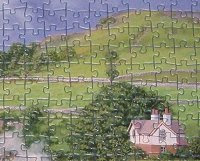 This was not a simple achievement! To see things from a suitable distance you need to have a camera position many times further away than the Moon.
This was not a simple achievement! To see things from a suitable distance you need to have a camera position many times further away than the Moon.A hundred and twenty times as far as the Moon would be fine, and this is what NASA has done.
Just think, the Moon circles the Earth once every 28 days, drawing out a circle half a million miles across. From our perspective the Moon glides past the starry constellations of the night sky.
But if we could travel far enough away we'd see the Moon sometimes one side of the Earth, sometimes the other, but never straying very far.
First, sit back and watch the movie. Then come back and read more of this blog post to find out how it was done.
In the year 1610 Galileo saw four points of light changing position night by night when he turned his telecope on the bright planet Jupiter. He realised that these points of light were circling Jupiter. It was final proof that not all celestial bodies orbit the Earth and therefore our planet cannot be the centre of the universe as was supposed by the mediaeval church.
This is exactly how the Moon would be seen to behave from a camera 31 million miles away, and this is what the video shows.
Here's how this amazing video was made. The Deep Impact spacecraft successfully investigated a comet in July 2005, but with its primary mission completed NASA decided it could usefully perform two further tasks. The Deep Impact team realised that they could also use the spacecraft to take images of the Earth and Moon, and they commanded the craft to take a series of images through four different colour filters at 15 minute intervals. Afterwards, the images were combined to make full colour versions and a series of the colour images were put together to make the video.
Learn more about Deep Impact (now renamed EPOXI) and the Earth/Moon video from NASA's website.







